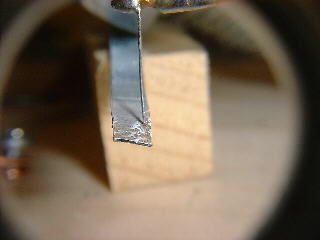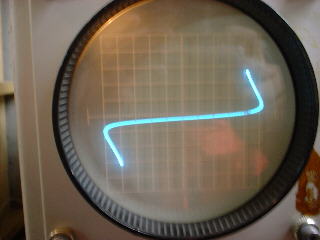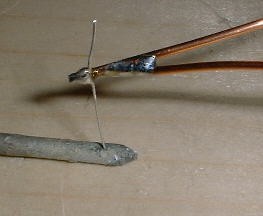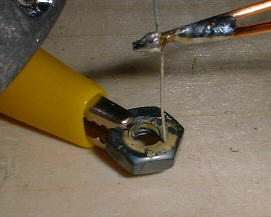



The end of a thin 1/8 inch wide strip of galvanized sheet metal, of the type used for furnace ducts, was held in the flame of a propane torch untill it glowed bright red. It is a good idea to do this out of doors and to avoid breathing any of the smoke or fumes. People who are knowledgeable about welding say that poisonus fumes are produced when welding galvanized metal. After cooling, small dark spots would appear, especially on the side opposite where the flame struck. These dark spots are the main negative resistance areas. The catwhiskers tried were 28 gauge steel wire and 30 gauge copper wire. Both seemed to work well. The circuit (as with the iron pyrites) seems to be very forgiving as to applied voltage level (pot setting).
As can be seen on the curve tracer, the curve can be quite symmetrical in both the negative and positive direction, although I sometimes would observe a more non symmetrical curve. It is also possible that applied dc could have some cumulative effect on the symmetry of the curve. This picture was taken while the curve tracer was applying ac to the device. I had to modify the curve tracer so it could apply ac.
The oscillator circuit can be run easily from one 9v battery and it seems easier to obtain steady oscillation when the catwhisker is biased negative with respect to the metal strip. Some steady oscillation was obtained however with the catwhisker positively biased. As with the Iron Pyrites oscillator, the frequency range seems to be limited to about 2 mhz.


I was able to obtain audio frequency oscillations using a piece of heat treated steel music wire but operation was unreliable and djustment was very difficult.
I was also able to get steady oscillations using some labatory grown pure bismuth crystals from a rock and mineral shop. It had a dark bluish color from a thin coating of bismuth oxide. It was a lot more stringent in it's voltage adjustment. The Bismuth oxide can have many interesting colors caused by light interference in the oxide coating.
I also obtained steady 40 mhz oscillations from a piece of pure silicon obtained at a rock and mineral show. It was supposed to be a byproduct from the semiconductor industry. It seemed to have a mind of it's own, oscillating between 10 and 40 mhz even though it was connected to an AM Broadcast Band LC circuit. It is also interesting stuff, but being from the sophisticated semiconductor industry, tends to defeat some of the fun of making an active semiconductor from materials found at home.
March 2002. A negative resistance device that seems almost indistinguishable from the heated galvanized sheet metal device was made by bringing a red hot flattened nail head in contact with a burning piece of magnesium ribbon. This seems to work about as well as the heated galvanized sheet metal for producing audio oscillations. Rf has not been tried yet.
I will try to keep this document updated for future developments.